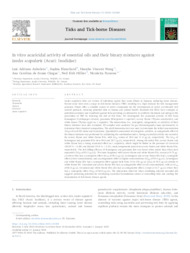In vitro acaricidal activity of essential oils and their binary mixtures against ixodes scapularis (Acari: Ixodidae).
In vitro acaricidal activity of essential oils and their binary mixtures against ixodes scapularis (Acari: Ixodidae).
Author(s): ANHOLETO, L. A.; BLANCHARD, S.; WANG, H. V.; CHAGAS, A. C. de S.; HILLER, N. K.; FARAONE, N.
Summary: Ixodes scapularis ticks are vectors of infectious agents that cause illness in humans, including Lyme disease. Recent years have seen a surge in tick-borne diseases (TBD) resulting in a high demand for tick management products. Plants offer a valuable source of active compounds for the development of novel, eco-friendly tick control products, reducing potential risks to human and animal health. Essential oils (EOs) have emerged as potential acaricides and repellents against ticks providing an alternative to synthetic chemicals and aiding in the prevention of TBD by lowering the risk of tick bites. We investigated the acaricidal activity of EOs from lemongrass (Cymbopogon citratus), geranium (Pelargonium x asperum), savory thyme (Thymus saturejoides), and white thyme (Thymus zygis) on I. scapularis. The interactions (i.e., synergistic, antagonistic, or additive) of their binary mixtures were also evaluated. EO samples were analyzed via gas chromatography-mass spectrometry to determine their chemical composition. The adult immersion test was used to determine the lethal concentration (LC50) of each EO alone and in mixtures. Quantitative assessment of synergistic, additive, or antagonistic effect of the binary mixtures was performed by calculating the combination index. Strong acaricidal activity was recorded for savory thyme and white thyme EOs, with LC50 values of 28.0 and 11.0 ?g/?L, respectively. The LC50 of lemongrass and geranium EOs were 49.0 and 39.7 ?g/?L, respectively. Among the tested EOs, savory thyme and white thyme had a strong acaricidal effect on I. scapularis, which might be linked to the presence of carvacrol (26.05 % ± 0.38) and thymol (53.6 % ± 2.31), main components present in savory thyme and white thyme EOs, respectively. The tick killing efficacy of lemongrass and geranium EOs was lower when mixed than when used separately (LC50 of 65.3 µg/µL). The same happened with savory thyme and white thyme EOs, except at 9.75 µg/µL where they had a synergistic effect (LC50 of 58.3 µg/µL). Lemongrass and savory thyme EOs had a synergistic effect at low concentrations, and an antagonistic effect at higher concentrations (LC50 of 95.4 µg/µL). Lemongrass and white thyme EOs had a synergistic effect against ticks from 15 to 120 µg/µL (LC50 of 18.5 µg/µL) similar to white thyme EO. Geranium and savory thyme EOs had an antagonistic effect at all concentrations, with an LC50 of 66.8 µg/µL. Geranium and white thyme EOs also had an antagonistic effect, except at 12.7 µg/µL where they had a synergistic effect (LC50 of 66.8 µg/µL). The interaction observed when combining selected essential oils suggests promising potential for developing acaricidal formulations aimed at controlling ticks and curbing the transmission of tick-borne disease agents.
Publication year: 2024
Types of publication: Journal article
Keywords: Carvacrol, Ixodes scapularis, Terpenoids, Thymol
Observation
Some of Embrapa's publications are published as ePub files. To read them, use or download one of the following free software options to your computer or mobile device. Android: Google Play Books; IOS: iBooks; Windows and Linux: Calibre.
Access other publications
Access the Agricultural Research Database (BDPA) to consult Embrapa's full library collection and records.
Visit Embrapa Bookstore to purchase books and other publications sold by Embrapa.

